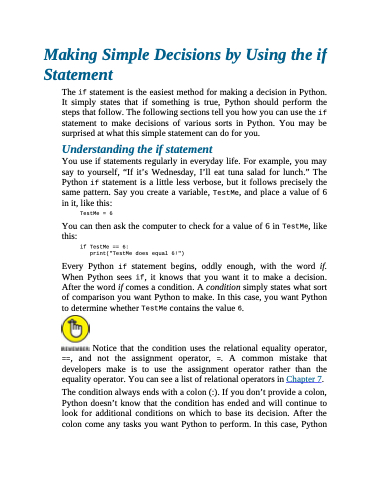Page 166 - Beginning Programming with Pyth - John Paul Mueller
P. 166
Making Simple Decisions by Using the if Statement
The if statement is the easiest method for making a decision in Python. It simply states that if something is true, Python should perform the steps that follow. The following sections tell you how you can use the if statement to make decisions of various sorts in Python. You may be surprised at what this simple statement can do for you.
Understanding the if statement
You use if statements regularly in everyday life. For example, you may say to yourself, “If it’s Wednesday, I’ll eat tuna salad for lunch.” The Python if statement is a little less verbose, but it follows precisely the same pattern. Say you create a variable, TestMe, and place a value of 6 in it, like this:
TestMe = 6
You can then ask the computer to check for a value of 6 in TestMe, like this:
if TestMe == 6:
print("TestMe does equal 6!")
Every Python if statement begins, oddly enough, with the word if. When Python sees if, it knows that you want it to make a decision. After the word if comes a condition. A condition simply states what sort of comparison you want Python to make. In this case, you want Python to determine whether TestMe contains the value 6.
Notice that the condition uses the relational equality operator, ==, and not the assignment operator, =. A common mistake that developers make is to use the assignment operator rather than the equality operator. You can see a list of relational operators in Chapter 7.
The condition always ends with a colon (:). If you don’t provide a colon, Python doesn’t know that the condition has ended and will continue to look for additional conditions on which to base its decision. After the colon come any tasks you want Python to perform. In this case, Python


